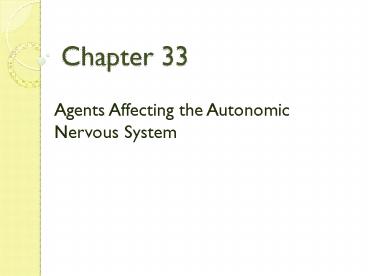Agents Affecting the Autonomic Nervous System - PowerPoint PPT Presentation
1 / 26
Title:
Agents Affecting the Autonomic Nervous System
Description:
Title: The Autonomic Nervous system & Antispasmodic Drug Action Author: Ramona Yehle Last modified by: administrator Created Date: 5/20/2006 1:39:30 AM – PowerPoint PPT presentation
Number of Views:92
Avg rating:3.0/5.0
Title: Agents Affecting the Autonomic Nervous System
1
Chapter 33
- Agents Affecting the Autonomic Nervous System
2
Autonomic Nervous System
- Includes two neurotransmitters
- Norepinephrine and acetylcholine
- Two branches
- Sympathetic
- Adrenergic
- Fight or flight
- Parasympathetic
- Cholinergic
- Rest and digest
3
Sympathetic Nervous System (SNS)
- Stimulates vital organs
- Suppresses nonvital body functions
- Signs of stimulation of the SNS
- Pupil dilation
- Bronchiole dilation
- Increased rate and force of contraction
- Blood vessel dilation in muscle tissue
- Increased breakdown of glycogen to glucose
4
Sympathetic nervous system receptors
- Alpha
- Found in smooth muscle tissue of peripheral blood
vessels and in the sphincters of the
gastrointestinal and genitourinary system
respond to norepinephrine - Beta
- Found mainly in the heart, lungs, and brain,
respond to epinephrine
5
Alpha Receptors
- Alpha 1
- - Primarily in the smooth muscle tissue of
peripheral blood vessels and the sphincters of
the GI and genitourinary (GU) tracts - - When stimulated, smooth muscle contracts
- Anorexiants dextroamphetamine (Dexedrine),
methamphetamine (Desoxyn)
6
Alpha Receptors
- Alpha 2
- - Functions as controllers of
neurotransmitter release - - When stimulated, release of
neurotransmitters from the presynaptic neurons
are decreased
7
Beta Receptors
- Beta 1
- - Primarily in the heart and fatty tissue
- - When stimulated, rapid heart rate, more
forceful heart contraction, and the breakdown of
stored fat to fatty acids occurs
8
Beta Receptors
- Beta 2
- Primarily in bronchial smooth muscle and the
walls of blood vessels - produces bronchodilation when stimulated by
adrenergic drugs - albuterol, epinephrine, terbutaline
- When stimulated, bronchial muscles relax and
diameter of airways increases
9
Adrenergic Receptors
- produces increased contractility, increased heart
rate, and AV and sinoatrial (SA) node conduction
when stimulated by adrenergic drugs - dobutamine, dopamine, and norepinephrine
10
Parasympathetic Nervous System (PNS)
- One neurotransmitter
- Acetylcholine
- Conserves energy
- Promotes nutrient use
11
Drugs Affecting the ANS
- Sympathomimetic adrenergic drugs
- Stimulate the system fight-or-flight
- Sympatholytic adrenergic blocking drugs
- Block alpha and beta receptors
12
Drugs Affecting the ANS
- Parasympathomimetic cholinergic drugs
- Mimic the PNS
- Parasympatholytic anticholinergic drugs
- Block acetylcholine receptors
13
Sympathomimetics (Adrenergics)
- Mimic the action of the sympathetic nervous
system - Neurotransmitters norepinephrine, epinephrine,
and dopamine (catecholamines)
14
Sympathomimetics (Adrenergics)
- Catecholamine receptor sites are where
adrenergics bind and produce their response at
locations throughout the body
15
Geriatric Considerations for Adrenergics
- More sensitive to the effects of adrenergics
- Must be monitored for excessive cardiac and CNS
stimulation - Signs and symptoms to watch for include
- - chest pain
- - palpitations
- - blurred vision
- - headache
- - seizures
- - hallucinations
- Notify provider immediately for these symptoms
16
Sympatholytics (Adrenergic Blockers)
- Block or inhibit the responses of adrenergic
neurotransmitters at the alpha and beta receptor
sites
17
Alpha-adrenergic Blockers
- Inhibits the response at the alpha receptors
- Causes vasodilation and decreases blood pressure
- Used to treat migraine headaches, hypertension,
and peripheral vascular diseases (promotes blood
flow to vasoconstricted areas)
18
Alpha-adrenergic Blockers
- Adverse effects can include hypotension,
dizziness, and ejaculation suppression - Commonly used alpha blockers are ergotamine
tartrate (for migraines), and tolamine and
prazosin (for hypertension)
19
Beta-adrenergic Blockers
- Blocks the beta receptor sites in the heart
- Decreases pulse rate and controls angina pectoris
- Decreases firing rate in the SA node and
conduction velocity in the AV node and therefore,
treats dysrhythmias
20
Beta-adrenergic Blockers
- They also decrease blood pressure and cause
bronchoconstriction - Use with caution in patients with asthma and COPD
- Some common drugs are propranolol, metoprolol,
and atenolol
21
Adrenergic Blockers
- Treat
- Hypertension
- Migraine headache
- Side effects/adverse effects
- Hypotension
- Dizziness
22
Adrenergic Blockers Geriatric Considerations
- Increase sensitivity to adrenergic drugs
- Monitor for
- Chest pain
- Palpitations
- Blurred vision
- Headache
- Seizures
- Hallucinations
23
Cholinergics
- Stimulate the PNS
- Treat
- Conditions with poor muscular contraction
- Neurogenic bladder
- Glaucoma
- Cardiac arrhythmias
24
Cholinergics Geriatric Considerations
- Increase sensitivity to cholinergic drugs
- Monitor for
- Diarrhea
- Increased bronchoconstriction
- Increased bronchial secretions
- Increased lacrimation
- Blurred vision
25
Anticholinergics
- Action
- Decrease gastrointestinal and respiratory
secretions - Dilate bronchioles
- Dilate pupils
- Treat
- Nausea
- Urinary incontinence
- Overactive bladder
26
Anticholinergics Geriatric Considerations
- Increase sensitivity to anticholinergic drugs
- Hyperthermia
- Urinary retention
- Decreased appetite































